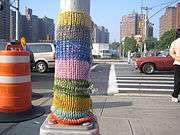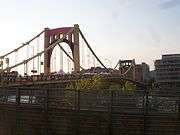Yarn bombing

Yarn bombing, yarnbombing, yarn storming, guerrilla knitting, kniffiti, urban knitting or graffiti knitting is a type of graffiti or street art that employs colourful displays of knitted or crocheted yarn or fibre rather than paint or chalk.
Method and motivation
While yarn installations – called yarn bombs or yarnstorms – may last for years, they are considered non-permanent, and, unlike other forms of graffiti, can be easily removed if necessary. Nonetheless, the practice is still technically illegal in some jurisdictions, though it is not often prosecuted vigorously.[1]
While other forms of graffiti may be expressive, decorative, territorial, socio-political commentary, advertising or vandalism, yarn bombing was initially almost exclusively about reclaiming and personalizing sterile or cold public places.[2] It has since developed with groups graffiti knitting and crocheting worldwide, each with their own agendas and public graffiti knitting projects being run.[3]
History

The practice is believed to have originated in the U.S. with Texas knitters trying to find a creative way to use their leftover and unfinished knitting projects, but it has since spread worldwide.[1][2][4]
The start of this movement has been attributed to Magda Sayeg, 37, from Houston, who says she first got the idea in 2005 when she covered the door handle of her boutique with a custom-made cozy.[5]

Houston artist Bill Davenport was creating and exhibiting crochet-covered objects in Houston in the 1990s, and the Houston Press stated that "Bill Davenport could be called the grand old man of Houston crocheted sculpture."[6] Artist Shanon Schollian was knitting stump cozies in 2002 for clear cuts in Oregon.[7] The Knit Knot Tree by the Jafagirls[8] in Yellow Springs, Ohio gained international attention in 2008.
The movement moved on from simple 'cozies' with the innovation of the 'stitched story'. The concept has been attributed to Lauren O'Farrell[9] (who creates her street art under the graffiti knitting name Deadly Knitshade), from London, UK, who founded the city's first graffiti knitting collective Knit the City. The 'stitched story concept' uses handmade amigurumi creatures, characters and items to tell a narrative or show a theme. This was first recorded with the Knit the City collective's "Web of Woe" installation[10] in August 2009.
The Knit the City collective were also the first to use O'Farrell's term 'yarnstorming' to describe their graffiti knitting, as an alternative to the more popular term 'yarnbombing'.[11][12]
Yarn bombing's popularity has spread throughout the world. In Oklahoma City the Collected Thread store yarn bombed the Plaza District of the city on 9 September 2011 to celebrate their three-year anniversary as a functioning shop.[13] and in Australia a group called the Twilight Taggers refer to themselves as 'fibre artists'.[14] Joann Matvichuk of Lethbridge, Alberta founded International Yarnbombing Day, which was first observed on 11 June 2011.[15]
Although yarnbomb installations are typically found in urban areas, Stephen Duneier, aka Yarnbomber, is the first to introduce it the wilderness with numerous permitted projects in Los Padres National Forest beginning in 2012.[16]
The Craft Club Yarnbombers (Emma Curley, Helen Thomas, Gabby Atkins, Claire Whitehead and Rebecca Burton) became Guinness World Record holders for the largest display of crochet sculptures, when they yarnbombed a children's hospice with 13,388 crocheted items.[17] They have also brought yarnbombing to their community in Essex with their postbox yarnbombs.[18]
Literature

In September 2009 Yarn Bombing: The Art of Crochet and Knit Graffiti[19] by Leanne Prain and Mandy Moore was published by Arsenal Pulp Press in Canada and the US.
In Europe Knit the City: Maschenhaft Seltsames[20] by Deadly Knitshade was published in February 2011 by Hoffmann und Campe in Germany. It was originally written in English, and was published by Summersdale in the UK in September 2011 as Knit the City: A Whodunnknit Set in London.[21][22]
Yarn Bombing Los Angeles released a self-published catalog of an exhibit held at 18th Street Arts Complex, Santa Monica, CA in June 2011 titled Yarn Bombing 18th Street[23] by Arzu Arda Kosar.
Gallery
|
See also
References
- 1 2 Wollan, Maria (18 May 2011). "Graffiti's Cozy, Feminine Side". The New York Times.
- 1 2 Anonymous (2009-01-21). "Knitters turn to graffiti artists with 'yarnbombing'". London: The Telegraph. Retrieved 2009-05-25.
- ↑ McGovern, Alyce (6 March 2014). "Knit one, purl one: the mysteries of yarn bombing unravelled". The Conversation. Retrieved 6 March 2014.
- ↑ Smee, Sebastian (2009-12-25). "Dave Cole takes knitting to new heights - The Boston Globe". Boston.com. Retrieved 2010-09-01.
- ↑ The Wild and Woolly World of Yarn Bombing, Street Art's Soft Sensation BLOUINARTINFO.COM
- ↑ Art: The Third Dimension, Houston Press, 1 June 2000
- ↑ "nw drizzle monthly arts, music & culture e-zine". Nwdrizzle.com. 2001-09-11. Retrieved 2013-05-09.
- ↑ http://jafagirls.blogspot.com/p/yarnbombing.html
- ↑ "London's graffiti knitters". Telegraph. May 2012. Retrieved 2012-05-05.
- ↑ "London's Graffiti Knitters". Telegraph Travel. The Telegraph. Retrieved 11 March 2012.
- ↑ Costa, Maddy (11 October 2010). "The Graffiti Knitting Epidemic". The Guardian. Retrieved 11 March 2012.
- ↑ Sillito, John (13 June 2009). "Knitting but not as we know it". BBC.
- ↑ "Collected Thread".
- ↑ "Twilight Taggers".
- ↑ Mollins, Julie (2011-06-10). "Graffiti knitters to hit streets on Yarnbombing Day". Reuters. Retrieved 13 June 2011.
- ↑ Cooper, Arnie (March 8, 2015). "The Guerrilla Art of the Yarnbomb Goes Natural". Newsweek Magazine. Retrieved 10 December 2015.
- ↑ http://www.guinnessworldrecords.com/world-records/largest-display-of-crochet-sculptures
- ↑ http://www.bbc.co.uk/news/uk-england-essex-30327928
- ↑ Prain, Leanne (2009). Yarn Bombing: The Art of Crochet and Knit Graffiti. Arsenal Pulp Press. ISBN 1-55152-255-1.
- ↑ Knitshade, Deadly (2011). Knit the City: Maschenhaft Seltsames. Germany: Hoffman und Campe. ISBN 978-3-455-38105-4.
- ↑ Knitshade, Deadly (2011). Knit the City: A Whodunnknit Set in London. London: Summersdale. ISBN 978-1-84953-179-5.
- ↑ "Foto's van Rosa Sosa". Facebook. Retrieved 2013-05-09.
- ↑ Kosar, Arzu (2012). Yarn Bombing 18th Street. CreateSpace Independent Publishing Platform. ISBN 1-47002-190-0.
Further reading
| Wikimedia Commons has media related to Knitted graffiti. |
- Lewis, Perri, Guide to Night: Mark Thomas joins the guerrilla knitters. The Guardian, 1 November 2009.
- Press Association US town baffled by Midnight Knitter. Irish Independent, 11 March 2010.
- "Knitting but not as we know it", BBC News, Saturday 13 June 2009
- Costa, Maddy, The graffiti knitting epidemic. The Guardian, 11 October 2010.
- 'Grandma Graffiti': German Knitting Guerillas Go Global, May 2011
- Knit Knot Tree Do Trees Get Cold-offbeat knitting USA Today AP 11 March 2008
- foxtoledo.com Making-Toledo-a-little-more-cozy--Yarn-Bombing-phenomenon-exploding-in-Toledo
- Milly, Jena. "Yarn Bombing isn't Knit and Run Anymore". Huffington Post. Retrieved 27 February 2012.
- Streetspun Yarnbombing Warm and Fuzzy - Yarn bombers leave colorful mark on city ToledoBlade Online 22 APR, 2012
- Urban Knitting Un ponte di lana Romagna.com 10 March 2014
- Cooper, Arnie Not Your Grandma's Crocheting ArtNews Magazine 18 Nov 2014
- Stewart, Ethan Knitting Psychedelic Daydreams Santa Barbara Independent 11 Sept 2014







